Have you ever fancied visiting India?
I had.
It was a country that never failed to catch my attention; possessing a vibrant culture, rich history and an outstanding cricket team. Last summer, I was lucky enough to be accepted onto the British Council’s Study India programme. I stayed in Delhi and Mumbai (all paid for by the British Council) before travelling, after the programme, to Jaipur and Pushkar.
My journey started at Heathrow, nestling down into my seat on the plane I gazed out as the sun started to disappear over the runway. It was a strange feeling, knowing that I wouldn’t be in my home country for the next month. Before Study India, the longest that I had ever left the UK was only a week and I was apprehensive about immersing myself into the Indian culture…and terrified about the prospect of suffering the dreaded ‘Delhi Belly.’
However, there wasn’t much time to ponder any worries as I got chatting to the person next to me who, coincidentally, was also jetting off for the Study India Programme. Before I knew it, we were in the clouds hurtling towards Delhi with drinkable tap water and my apprehensions about the next month left far behind in Heathrow.
8 hours later we touched down at Indira Gandhi International Airport (New Delhi) and walked out of the air-conditioned terminal into a muggy, chaotic yet exhilarating world. India. The heat really hit me at first; it wasn’t that I couldn’t cope with heat, I’d been fine 2 months before in the Sahara Desert, but it was the humidity. We’d arrived at the beginning of the monsoon season but I am so glad that we visited India during this period. Whenever we left the cities, especially Mumbai, the hills would be incredibly lush with green everywhere you looked. I’ve never seen people be so excited by the prospect of rain either. In England we’d moan but in India it is seen as the giver of life and it is not uncommon to see people dancing in the first few bouts of rain. It’s just so hard not to be taken in by their excitement.
The rest of my first day was a whirlwind of exhaustion and excitement. Leaving the airport, I endured my first experience of Delhi roads. The drivers are nutters. Our coach driver was stuck in a queue of traffic so what did he do? He drove straight over the central reservation into a lane of incoming traffic before veering back onto the right side of the road. 10 cars overtaken, no startled sleep deprived Brits dead. Success.
People were constantly arriving at the hotel and despite my body’s plea to sleep off the jetlag, I made the effort to meet people which mainly revolved around playing cards. This was one of the other benefits about the programme. Aside from having a heavily subsidised visit to India, I met so many other students from all over the UK and gained some useful contacts for the future.
Delhi was to be our home for the first half of the programme. To this day, I still can’t decide whether I preferred Delhi or Mumbai. However, to me Delhi is the heart of India. It has a rich history; Old Delhi was the centre of the Mughal Empire and is where some of the poorest yet most vibrant people reside. The British colonialists decided to build a new city next to Old Delhi, that remains the capital city and seat of government for India, calling it rather unimaginably…New Delhi. We were staying in New Delhi, arguably more affluent and cosmopolitan than Old Delhi.
The first day of the programme involved an introductory talk and guest lecture at the Lotus Temple. Possibly the most amazing place that I have ever had a lecture in. The building is a mother temple for the Bahá’í Faith in the subcontinent, a religion that I had never come across. Our first guest lecturer took us through the faith, based around the principle of unity; one of the greatest things about India is the diversity of religions. We received talks and/or visited places of worship for Islam, Sikhism, Christianity, Hinduism and the Bahá’í Faith. This diversity has historically caused conflict within India, occasionally persisting to this day, yet so many people that I encountered talked about the importance of not just tolerance but their pride in being Indian. It didn’t matter what religion, culture or caste…at the end of the day you were proud to be Indian.
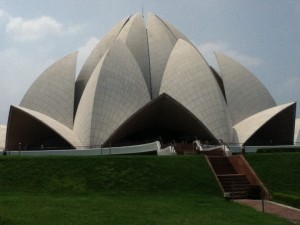
The next few days were a chaotic mixture of lectures in the evenings, in random places around Delhi, preceded by immersion excursions during the day:
One day we visited Old Delhi, it was humbling to see this city. It was how I thought India was going to be. New Delhi is a labyrinth of modern high rise buildings, flyovers and green spaces…the look of it could be that of any globalised city although the chaos and feel of the place reminds you that you’re in India. Old Delhi had a charm to it that matched the welcoming nature of the local people. We visited people’s houses where we ate with them and the girls received henna tattoos. However, people were living in squalid conditions and it really did highlight the massive divide that has become apparent between the rich and poor in India.
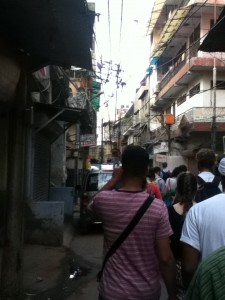
Another day, we visited the Taj Mahal…like the classic tourists. I knew what it looked like from pictures and thought that it might not be as spectacular in real life. I was wrong. It’s amazing and if you ever get the chance, visit it! Once you move away from the car park and all of the Del boys trying to sell you chess boards then you are greeted by a pathway to one of the most magnificent buildings in the world.
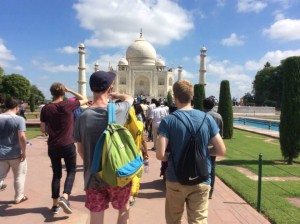
Surrounding the main building, there are mosques that would be considered wonders in their own right if they were not shadowed by the mausoleum. According to a local legend, the Taj Mahal was built by an Emperor for his third wife but apparently he wanted to build a replica of it, in black, across the river for himself. He was overthrown by his son before he could build it. Still, one Taj Mahal is enough to take your breath away.
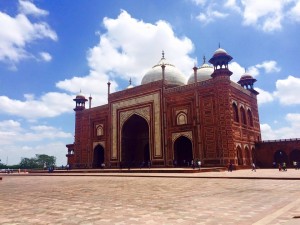
The next few days involved various activities around the city followed by lectures/discussions ranging from religion to colonial legacies to Bollywood. These lectures occurred throughout the programme and were delivered by renowned people.
The second half of our time in Delhi was spent at a designated campus at the University of Delhi. My group was allocated the Shri Ram College of Commerce…one of the most prestigious educational establishments in India! Our days consisted of lectures, discussions and activities alongside fellow Indian Students. We were assigned a ‘buddy’ who studied there and they participated in everything that we did. It was really interesting to just chat to them about our lives, they were similar yet different. One thing that stood out was their drive for educational success…these guys had to get nearly 100% in their finals to be accepted into their University. I didn’t mention my B in PE A level. However, this B definitely helped me when we played a cricket match against them. It was a tight game with India just coming out on top…but we restored our pride by briefly having a kick about with some students nearby, the English were definitely better than the Indians when it came to football! I’m still in contact with my buddy and other peers that I met at Delhi University; it’s good to know that I have that connection should I ever visit India again and vice versa.
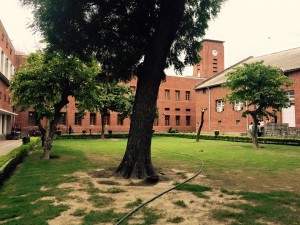
Our time in Delhi was drawing to a close but on the last day we were able to visit the garden where Gandhi was assassinated. Normally these historical sites lose their feel due to over commodification. However, the area felt like it breathed history as the garden along with the house had been left alone, reinvigorating the memory of Ghandi’s last few days.
Amongst other things we had also visited the British Council’s office for a dinner party, been given an open air concert in the grounds of an old ruined castle as well as had some free time to walk around the city to visit markets and shops.
Before we knew it, we were squashed onto a train trundling down to Mumbai. This journey was savage for those suffering from ‘Delhi Belly’ with most of the toilets being a squat hole over the train tracks. However, I was blessed not to have been struck down by the dreaded illness so the journey was a pleasurable one with amazing views, long conversations and a lot of card games. The beds (doubling up as sofas), despite feeling pretty precarious, were surprisingly comfortable. As I slowly awoke with sleepy eyes, we were pulling into Mumbai.
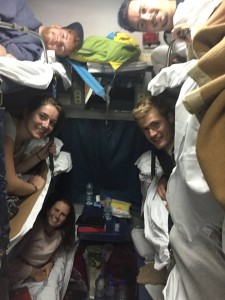
Mumbai felt a lot more cosmopolitan than Delhi and dare I say it, slightly less chaotic. Our hotel felt like it was straight out of the 1920s with a traditional lift that had a well-dressed man operating it. The only thing stopping me from feeling like I was in The Great Gatsby was the broad Stoke accent of my roommate.
If Delhi was the heart of India, then Mumbai was the brain. A lot of the lectures and excursions in the following days revolved around business. We visited an entrepreneurial space at the top of a skyscraper where a lot of Mumbai’s brightest start-ups were nurturing their fledgling businesses, this presented a great opportunity to network with some potentially valuable contacts.
We were also fortunate enough to visit Dharavi. If you studied GCSE Geography, then you probably came across Dharavi as a case study for urbanisation although most people know it from the film ‘Slumdog Millionaire.’ It is considered to be one of the largest slums in Asia yet it has a vibrant economy with many entrepreneurs. Goods are exported from Dharavi to all over the World. Reality Tours guided us around Dharavi and highlighted the emerging tourism to the area. During the evening, we had the opportunity to partake in a question and answers with residents of Dharavi. They emphasised the importance of community to the area. Not all riches are monetary.
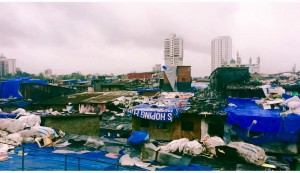
On one day we ventured deep into the countryside to experience rural India. It was a stark contrast to Mumbai and people seemed a lot more conservative. During this excursion we got to participate in Holi…at first people were apprehensive of the stagnant water being thrown over us along with paint but everyone got into the spirit of it. A carnival atmosphere erupted and people were even jumping into the (suspiciously brown) lake!
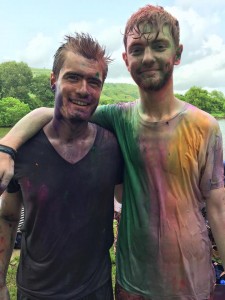
Like in Delhi, we were receiving lectures in the evening and sometimes during the day at various venues around Mumbai. On one day, we received a talk in the Wankhede stadium from a member of the British diplomatic service. The girls didn’t seem to appreciate the venue as much as the guys did! Having procrastinated from university work numerous times by watching the IPL, it was great to see an iconic cricket ground in the flesh.

There are too many activities to cover in this blog but some other highlights of our time in Mumbai included:
Riding through the city on bikes as the sun started to rise. Dawn was the only possible time to cycle on the roads before the traffic became too chaotic!
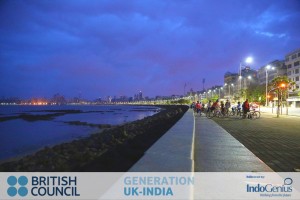
Visiting a mosque that was only accessible at certain times. The road to the mosque would be submerged below the ocean during high tide so we could only go in the evening. It was here that we became local celebrities as many people wanted their picture taken with the funny looking British tourists.
During a visit to an all-girls school, I taught French to numerous classes alongside some of my peers. The students were very enthusiastic to learn a language that they had never come across!
The food in India was an experience in itself as well. One of my favourite discoveries was Paneer (cheese) Curry. Yes, let that sink in…cheese curry! It may sound strange but it tasted amazing. You could even get Paneer Curry as a pizza topping at the Dominoes in Mumbai airport!
India’s Pringle game was also pretty strong.

The programme eventually came to a close with a party in the hotel where awards were handed out and a lot of food consumed. The last evening was pretty stressful as I had no idea where I was going to explore after the programme finished…aka the next morning. On the final night, I met people who wanted to explore Northwest India as well. Eventually, as people leaving for the UK the next day passed out, I booked my flights to Jaipur.
Jaipur is famously known as the ‘pink city.’ Everywhere was painted pink during the colonial era to welcome Queen Victoria and the colour has persisted to this day. Jaipur is perhaps most famously known as the setting for the Best Exotic Marigold Hotel. Monsoon fully struck during our time in Jaipur, it was a particularly moist trip to the Amber Fort.
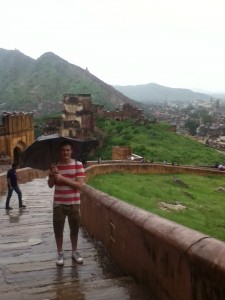
Amongst other things, we visited the Jantar Mantar (an outdoor observatory with the world’s largest sundial) and the City Palace. On the final night, we climbed up to the Monkey Temple (named after the many pesky monkeys knocking about there) where we watched the sun set over Jaipur. The view was incredible. The pink city is constrained by surrounding ridges so from our high vantage point you could see over the whole of Jaipur.
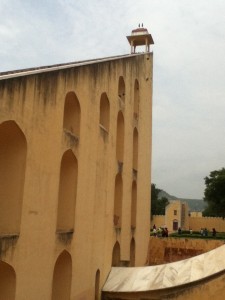
Following Jaipur, we travelled via train to Pushkar for a few days; a small town based around a holy lake. Climbing onto the roof of our hotel there, you can see surrounding luscious green countryside dwarfed by the two nearby mountains.

The markets in Pushkar were bustling and the energy of the locals infectious. During my time here I also became acquainted with an Israeli couple, who really highlighted how lucky I am to hold a British passport. It can be easy to take a passport for granted but as a UK citizen, unlike Israelis, I’m able to visit practically any country in the World…a luxury that I think we often forget.
However, my time in India was not completely rosy. Whilst walking through Pushkar, with a good friend who was black, some teenagers started pointing at me and screaming ‘horrible skin, bad person’ only a few metres in front of me. They then turned to my friend and exclaimed ‘lovely African person, good skin’. In one sense, I felt dejected, alienated, suddenly desiring to leave India as soon as possible. On the other hand, it was fascinating and humbling to experience racism as I had never been in this position having grown up in a dominantly White-British society. You can talk as many times as you like about how nasty racism is but only when you experience it do you fully understand how grotesque it is.
Throughout my time in India, I had mixed experiences of Tuk-Tuks. These are small three wheeled motorbikes that will take you anywhere for a small fee. During my final day in Delhi, a sociable old Tuk-Tuk driver gave me an insight into Old Delhi recounting his views on everything from politics to curry. However, many Tuk-Tuk drivers in Jaipur were not so pleasant…harassing you and taking advantage of tourist’s confusion at any transport hub.
If you can bear being inches away from lorries and horses, ten times the size of you, whilst hurtling through chaotic streets…I recommend taking at least one journey in a Tuk-Tuk. It’s terrifying, exhilarating and exhausting but a true piece of India.
My Indian summer concluded back in Delhi. On my final day, I had enough time to jump on the metro, a feat I hadn’t thought that I’d manage on my own when I first arrived, to visit Delhi Gate. Unfortunately, I couldn’t get close as security was tight due to preparations for Independence Day but I did have my picture taken with a lot of locals again. You’ve got to enjoy being a celebrity whilst you can.
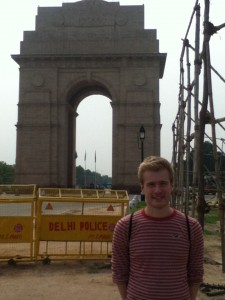
It had been a whirlwind of a month. Looking back, I met so many new people that I’ll stay in contact with for the rest of my life and gained experiences that will be hard to rival. It had also greatly increased my confidence by immersing myself in another culture. Lastly…I had discovered that cheese curry was actually a thing!
As I jetted off back towards the UK, I wondered whether I’d return to India one day. I think that I will. India is a hugely diverse nation and during my time abroad I had only scratched the surface. Kerala, Kashmir, Kolkata…all places in India that I hadn’t come close to experiencing.
The programme has changed a bit since I went on it last year but if you’re interested in finding out more then go to the British Council’s website:
https://www.britishcouncil.org/study-work-create/opportunity/study-abroad/india
All of the programmes still offer a heavily subsidised chance to experience India!
There are also similar opportunities with the British Council to study in China:
https://www.britishcouncil.org/study-work-create/opportunity/study-abroad/china
My advice would be that there is no harm in applying. For the experiences and people that you meet, it’s a fantastic opportunity.
